[responsivevoice_button rate=”1″ pitch=”1.2″ volume=”0.8″ voice=”US English Female” buttontext=”Story in Audio”]
MSI GS66 Stealth Review: Thin and small, with a 300Hz screen
The MSI GS66 Stealth is the latests GS-series laptop from the company, and it continues the tradition of pushing the envelope on thin-and-light gaming machines.
With the GS66 Stealth, MSI redesigns the trend-setting GS65 Stealth to be, well, a bit stealthier—and stylish. Gone are the red-and-black logos that screamed ‘gamer,’ as well as the gold accents of the two previous designs. The new GS66 (currently $2,999 on Amazon) is designed to slip right into those boring corporate meetings with other sedate black business laptops. Once you’re off the clock, it screams with all the might you’d expect from an Intel 10th-gen, 8-core Core i9-10980HK and Nvidia GeForce RTX 2080 Super Max-Q GPU. Keep reading to find out more about this trendsetting gaming laptop.
This review is part of our ongoing roundup of the best gaming laptops. Go there for information on competing products and how we tested them.
MSI GS66 Stealth Specs
As you read through the specs for the GS66 Stealth, remember that this is one of the thinnest gaming laptops available. The GPU is a power-efficient Max-Q design, but otherwise there are few compromises packed into this slender body.
CPU: Intel 10th-gen, 8-core Core i9-10980HK
GPU: Nvidia GeForce RTX 2080 Super Max-Q
RAM: 32GB DDR4/2666 in dual-channel mode
SSD: 1TB NVMe Samsung PM981
Networking: WiFi 6, Killer NIC 2.5Gbps ethernet, Bluetooth 5.1
Battery Capacity: 99.9 Watt-hours
Dimensions: 14.2 x 9.7 x 0.7 inches
Weight: 4.6 pounds, add 1.9 pounds for the AC adapter
The best way to describe the generous port selection on the GS66 Stealth is with photos. On the left side, as shown below, you’ll see (left to right) the dedicated charging port, Thunderbolt 3, HDMI 2.0, and SuperSpeed USB 10Gbps Type-A.
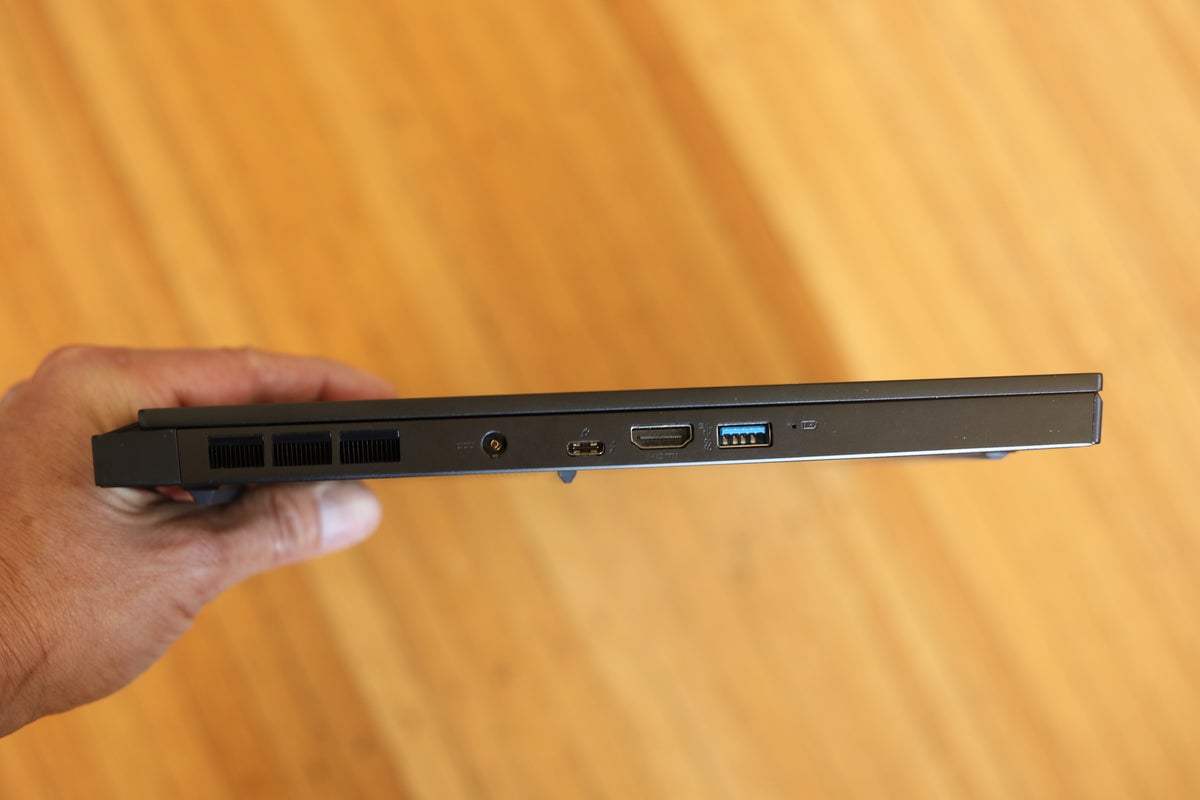 Gordon Mah Ung
Gordon Mah UngThe left side of the GS66 features (left to right) a dedicated charging port, Thunderbolt 3, HDMI 2.0, and SuperSpeed USB 10Gbps Type-A.
One thing the GS66 Stealth lacks is an integrated SD Card reader. But we understand space is at a premium. When you add up everything on the right side (below), we like what you get instead: two more SuperSpeed USB 10Gbps USB-A, a SuperSpeed 10Gbps USB-C, analog headset jack, and nicest of all, a Killer NIC E3100-based 2.5Gb ethernet port.
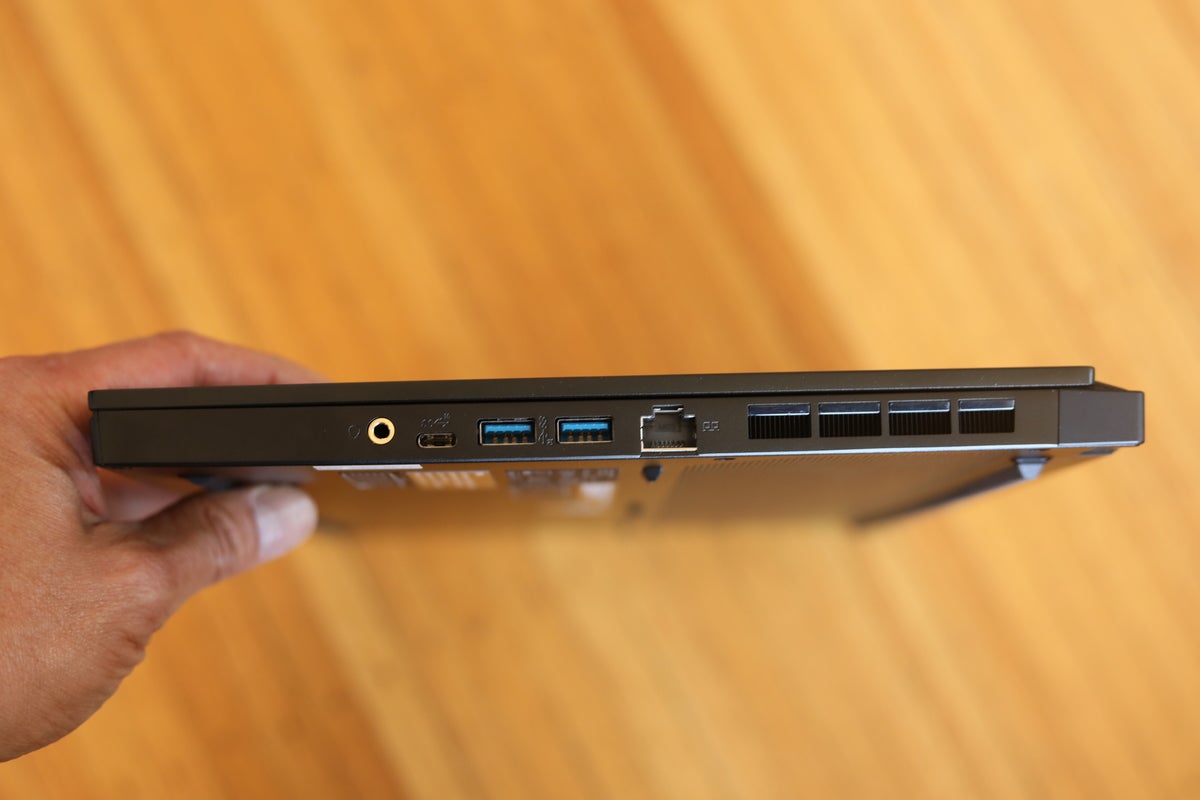 Gordon Mah Ung
Gordon Mah UngThe right side features analog headphone jack, two SuperSpeed USB 10Gbps USB-A ports, a SuperSpeed USB 10Gbps USB-C, and 2.5Gb ethernet.
The 300Hz display matters!
Most notably, MSI has equipped the GS66 Stealth with a 15.6-inch 1080p (1920×1080) 300Hz panel with a rated 3ms response time. Yes, you heard that right. Your 144Hz gaming laptop screen is basically obsolete.
We’re mostly kidding, but times are changing. While we used to believe that high-refresh-rate gaming monitors were only useful for those with bionic vision and lightning reflexes, we’ve since found that higher refresh rates make a huge difference for anyone. The more information you see on the screen, the better chance you have of making the shot in a game. Actually, any content that is scrolled on the screen and refreshed can benefit from a reduction in the blurring we’ve all just gotten used to with LCD screens.
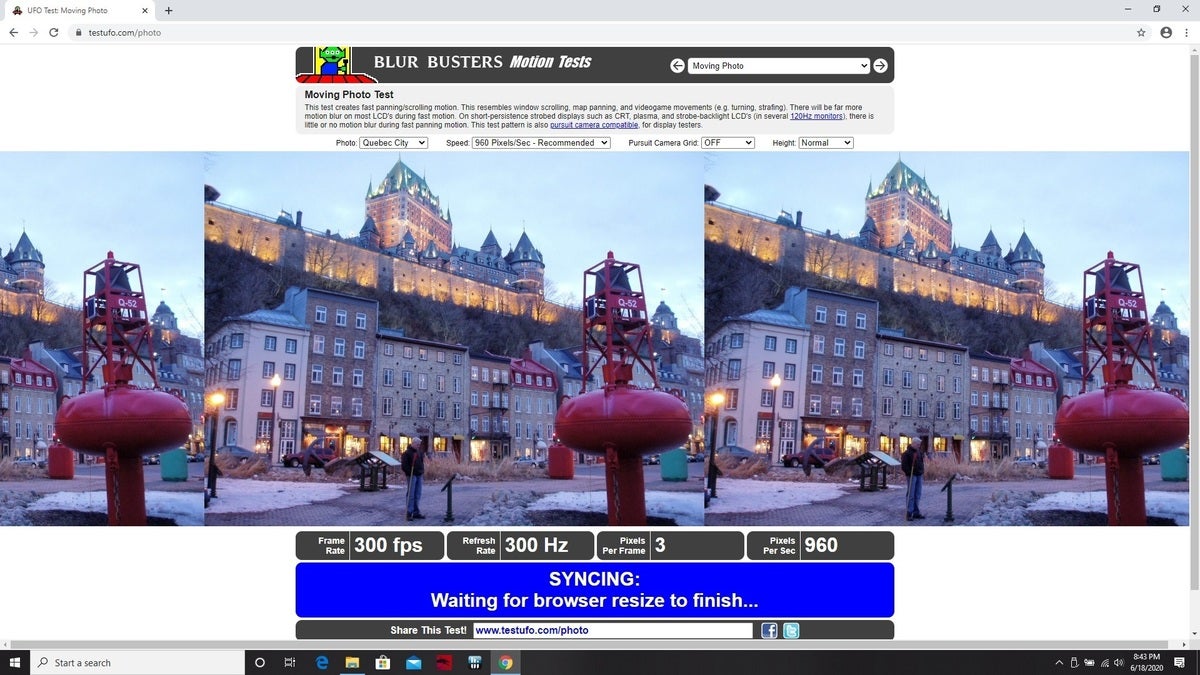 IDG
IDGThis photo test at Blur Busters testufo.com scrolls a photo at maximum refresh of the panel. It was nearly tack-sharp on the 300Hz MSI GS66 Stealth’s panel.
To see if our eyes could tell, we went to Blurbuster’s Testufo.com. Blurbusters has long been a pioneer in the push to reduce blurring during motion. For comparison we set up side-by-side with the GS66 Stealth a 15.6-inch gaming laptop with a 144Hz panel, and a 15.6-inch 4K 60Hz gaming laptop. We then used Testufo.com to scroll a simple, 80s-era-like UFO animation on all screens, as well as Testufo.com’s Moving Photo test. (You can run the tests yourself by using Chrome and going to Testufo.com).
The 4K, 60Hz screen was the blurry mess we expected. The 1080p, 144Hz panel was markedly better. But yes, the 300Hz, 3ms panel in the GS66 Stealth put both to shame, displaying the scrolling photo with near tack-sharpness to our eyes. Our eyes say it’s worth it if your enemy is blurring.
MSI GS66 Upgrade paths
One sin of previous 15.6-inch GS-series laptop designs was the use of inverted motherboards, which had to be removed entirely to access the SSD and RAM. With the new GS66 Stealth, no such gymnastics are needed—just pop off the bottom panel, and the two SO-DIMM slots and two M.2 slots are right there.
Keyboard and trackpad
The keyboard on the GS66 is slightly mushy, but overall we’d say it’s fine. The trackpad is oversized and continues to be centered a little too far to the right for our fat palms. Palm rejection, however, is quite good. The Microsoft Precision-enabled trackpad is works smoothly and responsively.
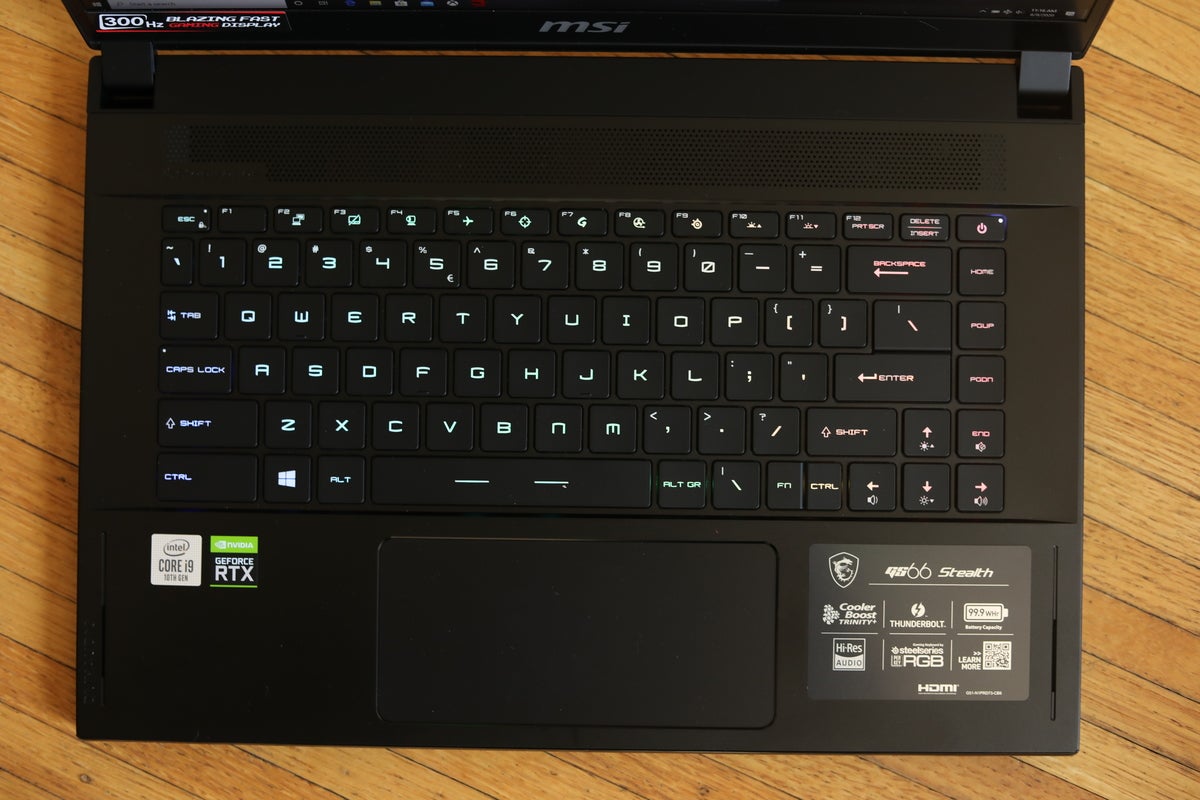 Gordon Mah Ung
Gordon Mah UngThe keyboard is per-key lit and features a wide-aspect Precision trackpad, which is among the smoothest our fingertips have ever touched.
Speakers and Camera
MSI likes to highlight that the GS66 Stealth’s speakers feature vents aimed at the user, while other laptops choose to fire the audio to the side or bounce it off the table. Unfortunately the audio is still pretty mediocre. We know it’s hard to jam all this hardware into a thin laptop, but MSI seems to have shrugged off the audio.
MSI does somehow fit a Windows Hello biometric camera into the GS66 Stealth’s slender bezel. Most gaming laptops choose fingerprint readers or give up on biometrics entirely, so having a Windows Hello camera in a gaming laptop is welcome. Image quality for your Zoom video conferences is fair—it’s a 720p video camera, the same resolution you’ll find on the vast majority of laptops out there.
MSI GS66 Stealth Performance
With the GS66 Stealth we were honestly concerned whether you could jam a Core i9 with an RTX 2080 GPU into a sub-5-pound, 15.6-inch laptop without compromise. After all, these must be a reason why so few vendors have tried this before.
As modern performance laptops are often tuned to be quieter and cooler out of the box, we tested the GS66 Stealth using both its default “Balanced” performance mode and its “Extreme” setting as well. You’ll see the results from both settings below.
CPU Performance
We’ll kick this off with the now-elderly Cinebench R15 test, which measures multi-core 3D modelling performance. Note that the default Balanced performance of the GS66 Stealth (the shorter red bar below) is a bit underwhelming. That’s because MSI reduces the fan noise in this setting to keep users happy, which forces the laptop to throttle CPU performance to keep cool. In this case, MSI plays it perhaps too conservatively.
Note that when we first received the GS66, default multi-core performance was far better—but it also kicked fans on far sooner. The company pushed out a BIOS and firmware update to address complaints, and the result on default is the shorter red bar you see below.
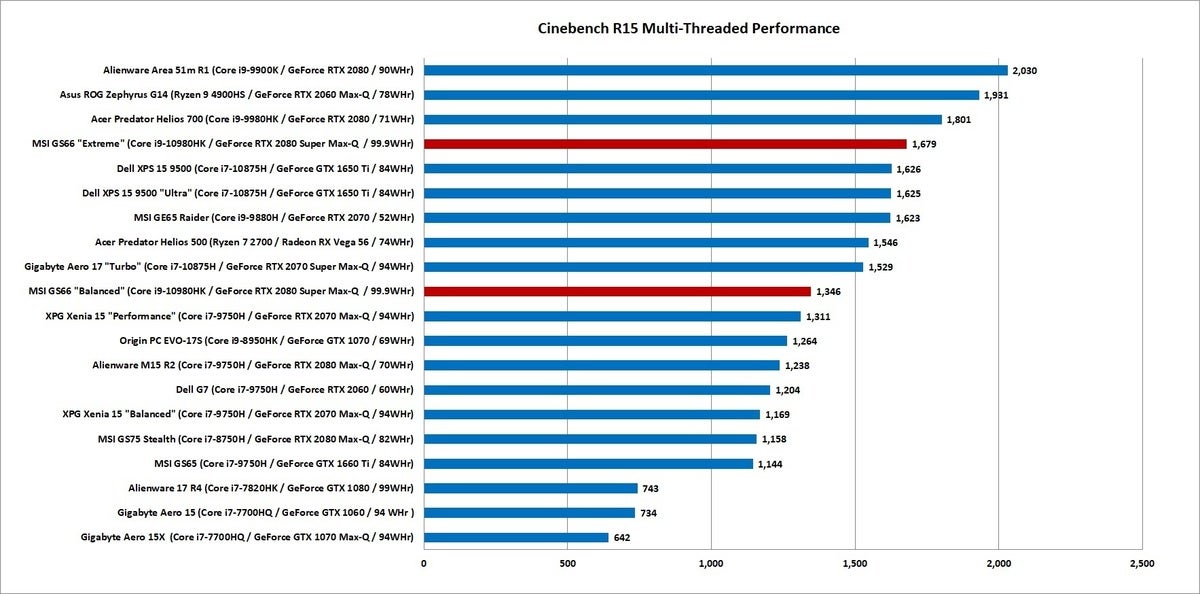 IDG
IDGFortunately, when you set the GS66 Stealth to Extreme, it starts to come to life—see longer red bar above. While it doesn’t push aside the two far larger Intel laptops (nor that pesky AMD one), it’s about what we’d expect for a laptop this thin with an 8-core Core i9 inside.
We used Cinebench above to get a general feel for multi-core performance, but the vast majority of applications are single-threaded—and Cinebench can measure that, too.
The story here is a bit different: The GS66 Stealth pulls its weight and is outpaced only by three 17-inch laptops. But as you can see, the results are all so close, it’s be hard to tell the difference based on single-core CPU performance for most tasks. The shorter red bar below is the Balanced result, while the longer one is the Extreme result.
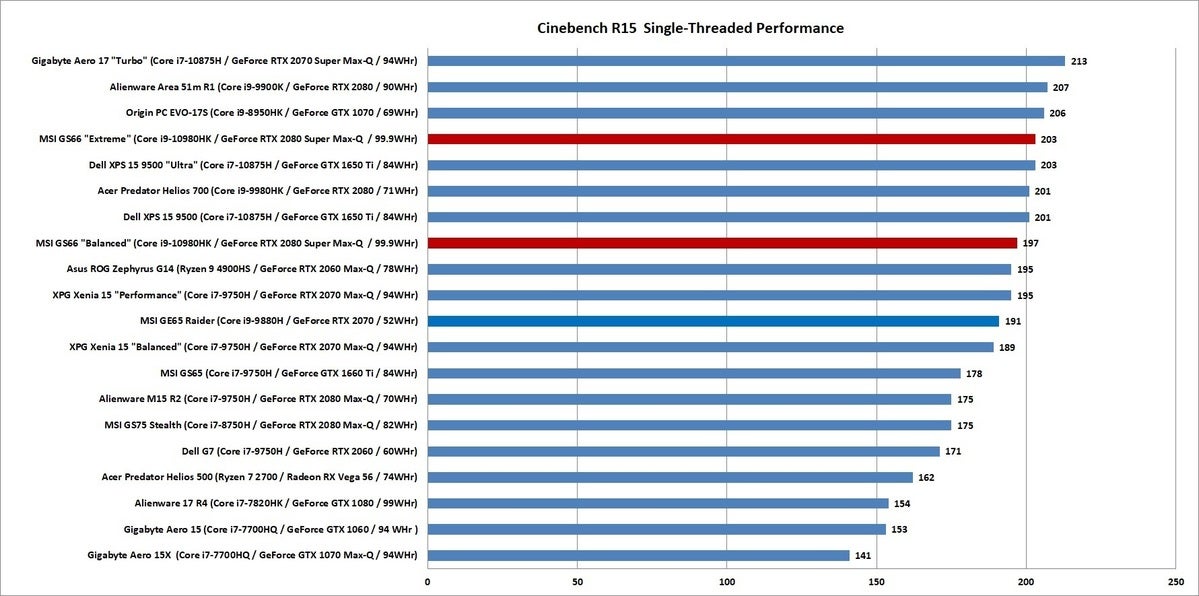 IDG
IDGWhile the “Extreme” setting creates more fan noise, we observed that the Gigabyte Aero 17, when set to its top performance setting, is even louder than the GS66 Stealth.
Because the Cinebench test is brief—basically a sprint, we run a second CPU test that’s more of a marathon, so we can see how the CPU performs under extended load. For that we use the free HandBrake video encoding utility to convert a 30GB file using the Android Tablet preset.
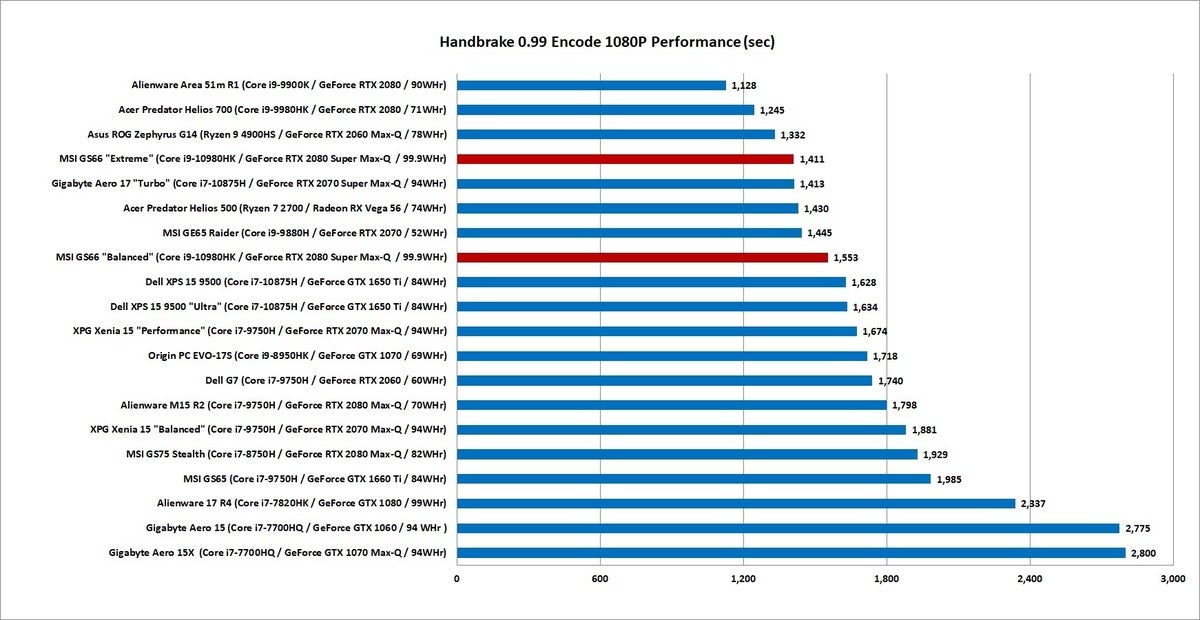 IDG
IDGIn this test, shorter is better. The result is again good when set to Extreme (the shorter red bar above), but somewhat less so when set to its default Balanced. The GS66 Stealth also struggles to keep up with the Gigabyte Aero 17, which is an 8-core chip but a step lower (Core i7-10875H). That Ryzen 9 4900HS doesn’t help either.
Overall CPU performance for the GS66 Stealth is respectable when set to its fan-heavy Extreme setting, and just OK when set to its default Balanced setting.
The GPU matters more for gaming, so keep reading for graphics results.



























